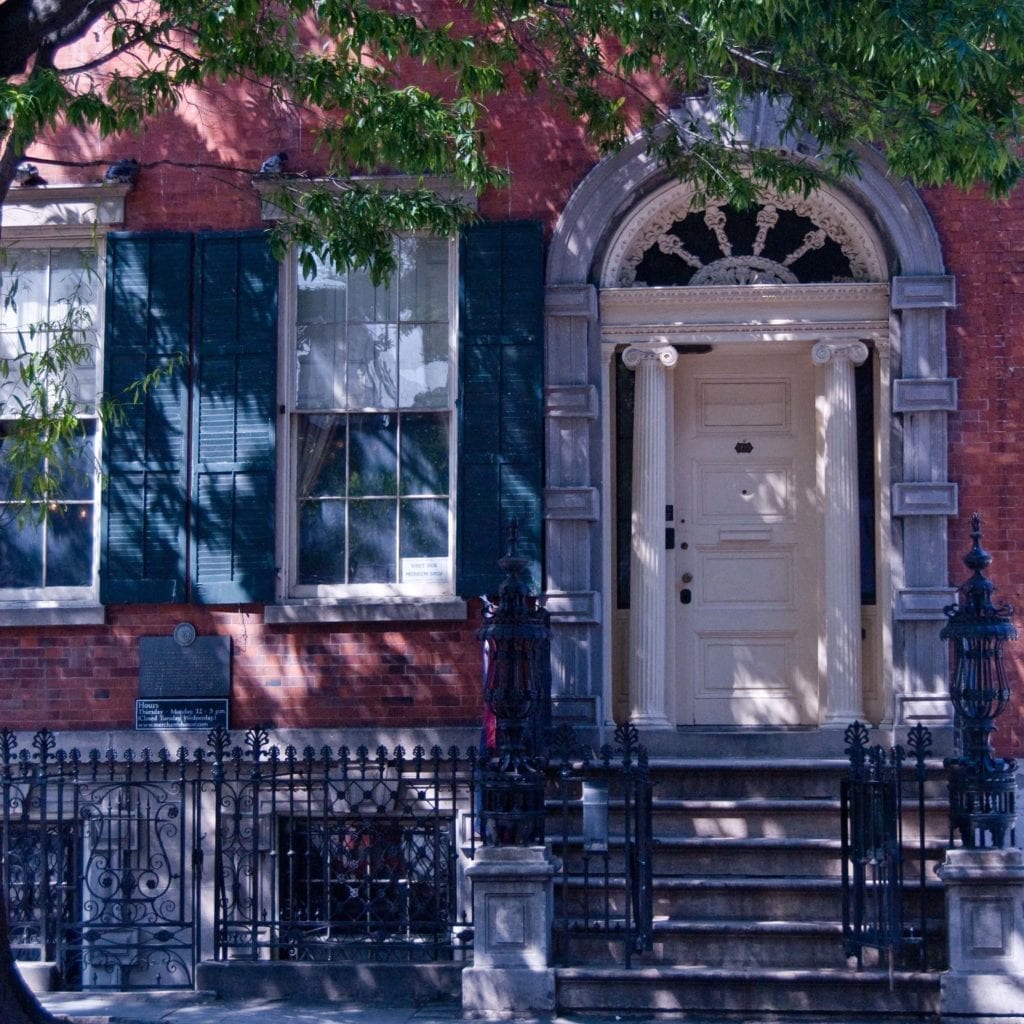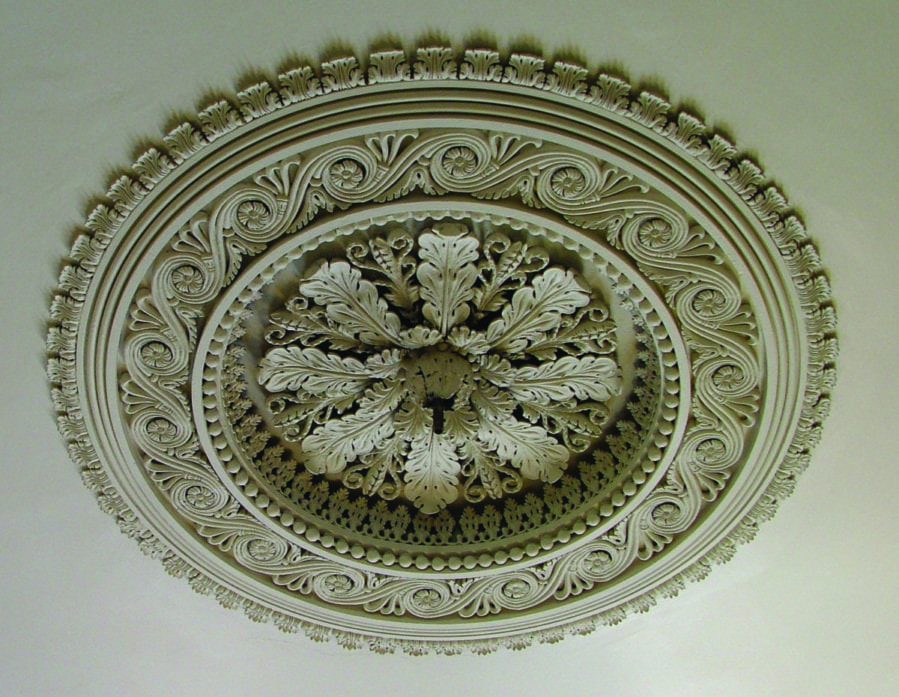Imagine a hundred years kept in a townhouse time capsule. That’s what it’s like at the Merchant’s House Museum. It’s much more than Manhattan’s first landmark. This one’s personal. Thanks to the Tredwell family, we can explore this historic home as it was in the 1800s.
Listen to the podcast version of this with a click below.
It’s packed with clothes, personal items, furniture, and everyday life. The bread box still has a lock and key to keep servants out. Their bells hang near the ceiling. But most of the museum contents belonged to Gertrude Tredwell – the lady of the house. These objects are what make Merchant’s House Museum so special today.

Living History @ Merchant’s House Museum
Living history represents more than a trend for history lovers. It engages everybody. That’s because it draws viewers in with articulate, costumed historians, and personal items. These details help make stories tangible. History education evolves. And so has the way we tell its stories. For far too long the privileged have told history’s tales through a single lens. On its face, the Merchant’s House Museum may seem unexceptional on this point. Owned by only one rich family, the story seems simple on the surface.
So, most Merchant’s House Museum tales are stories of privilege. But even that’s changing. In fact, during my visit, I learned of an upcoming book about one of the Tredwell servants. These were young Irish women, fresh off the boat, as they say. Their spare attic room holds tiny wrought iron beds. Each has the thinnest pad for a mattress. Imagine an old school maxi pad stretched over a bed frame… or visit the museum to see for yourself.
Clean Water Leads to Longevity
Still, Merchant’s House Museum’s main storyteller remains Gertrude Tredwell. Born in 1840, she lived her whole life in this house. That means almost every day until her death in 1933, days before her 93rd birthday. The exception to this rule? A Jersey shore summer home in Gertrude’s younger years. How did she live almost 100 years? After all, lifespans were about half that on average back then. It’s likely the Tredwell family’s bottled drinking water helped.
In the late 1800s and early 1900s, NYC water wasn’t clean like today. So, rich families like Gertrude’s bought bottled water. Thanks to this practice she likely avoided illness. Also, her nutrition and hygiene were typical upper class. Healthier lifestyles like this can often increase longevity. This fancypants living didn’t last all of her 93 years, though. Gertrude died poor. She had long ago let go of her servants and simplified her lifestyle.
History Cheers for Hoarders
As a result, she latched onto the remnants of her high-class life. Much like a hoarder, Gertrude didn’t let the past go. The Merchant’s House Museum thus remains filled with her belongings. There’s a prestigious Duncan Phyfe dining set… and even a metal vaginal syringe. Of course, most of the goods are everyday items; from books and bureaus to her immaculate lace dresses. There’s massive storage in the museum’s possession far exceeding what they can display at any one time. So, curators transition between themes to keep exhibits fresh and fascinating. That means there are new reasons to visit every time the seasons change.
Visitors Call on Gertrude Tredwell
Every year Merchant’s House Museum re-enacts the Tredwell patriarch’s funeral. Museum workers don actual Tredwell mourning clothes. A requiem service begins in their grand formal parlor then travels to a nearby cemetery. It then concludes at Seabury Tredwell’s grave. The ceremony feels real thanks to meticulous research. Tredwell family diaries are lacking. Luckily, though, their cousin and neighbor John Skidmore wrote a lot about the family. There are also other historical diaries that speak of the Tredwells.
In other words, we can thank the weaker side of humanity – talking about others. People often can’t help but chit chat about each other. In fact, parlor visits were common practice in Gertrude’s time. This meant gossip. Guests came to call and shared their card at the front door. A servant then showed Gertrude the calling card. She’d either nod yes or no for the visit. When you stand in the Merchant’s House Museum parlor today, it’s easy to imagine this. In fact, the cards are there to help your imagination.
Even if she declined them, Gertrude still “owed” them a visit. If welcomed into the parlor, they would stay about ten minutes. That’s only enough time for a mood check and bit of gossip. Callers were then swept off and on their way to the next house. This was how she and her peers passed the time in those pre-social media days.
Merchant’s House Museum Stories Stay Alive
Many say the Henry James novel Washington Square tells Gertrude Tredwell’s sad story. In the book, the protagonist, Catherine’s, parents cockblock her most ardent suitor. Thus, she’s a doomed spinster. This meant a lonely life at that time. And all because they didn’t think he was good enough for her. It’s a beloved and familiar story we’ve all heard before. In fact, The Heiress, based on James’ novel revived many times with great success on Broadway.
Whether these performances tell Gertrude’s true story we’ll never know. She’s not here to tell us. But many Merchant’s House Museum visitors still hope to someday hear her. That’s because they book ghost encounter tours of the paranormal variety. These are popular around Halloween but offered year-round. In fact, they’re so much fun, MHM earned the title “Manhattan’s Most Haunted House” from the New York Times. Visit the website to find the latest events. That way you can experience these wonders yourself. They also share cool virtual events. So, you don’t even need leave the house to check it out.
Already a Museum in 1933
Even if there’s no major event when you visit, it’s a rad museum. When Gertrude died she was the last member of the Tredwell family and poor. Thus she didn’t upgrade much. Even at the time of her death in 1933, the place already felt like a museum. Sure, some of it wore down with age. But it was ALL old and original. From the bed where she was born to the horsehair couch and player piano. That’s why Gertrude’s cousin, George Chapman decided to take on the house and turn it into a museum.
He was well-known as a rescuer of all things old and beautiful. In fact, Chapman called himself a “sucker for old houses”. Thank goodness for kindred spirits like good old George. If this feels right to you, make sure to add Merchant’s House Museum to your next Manhattan to-do list. It’s such a charming way to visit the past and slip into intriguing stories from historical New York City.
I’m grateful to Historic Houses Trust of NYC. They made my visit to Merchant’s House Museum extra special. I’m excited to see all 23 of their historic home sites across NYC’s 5 boroughs. Travel 367 years of history right along with me! Check ‘em out here @hhtnyc and visit their site – http://HistoricHouseTrust.org.
